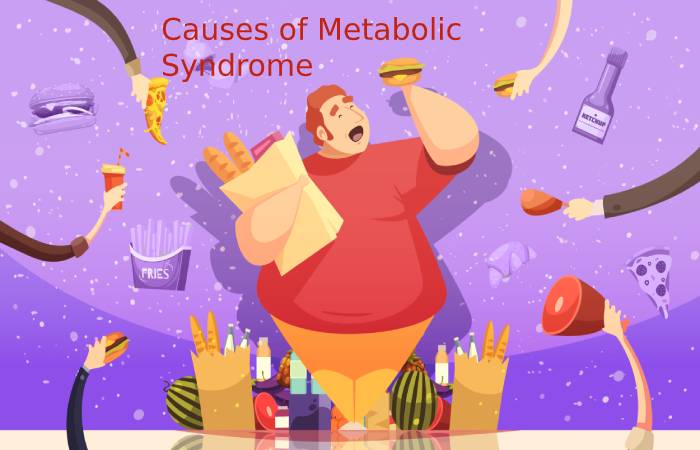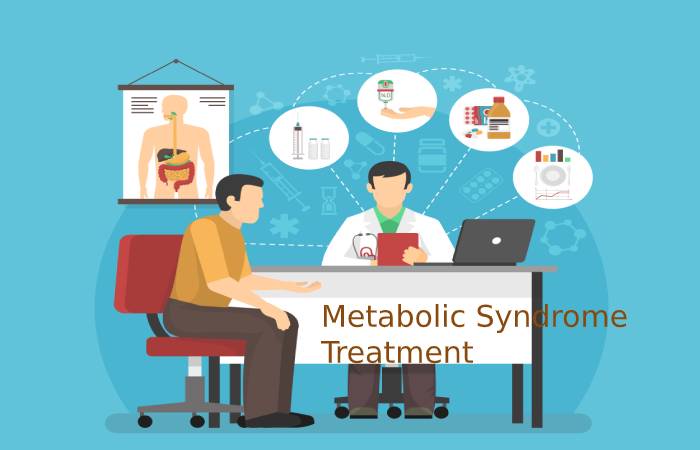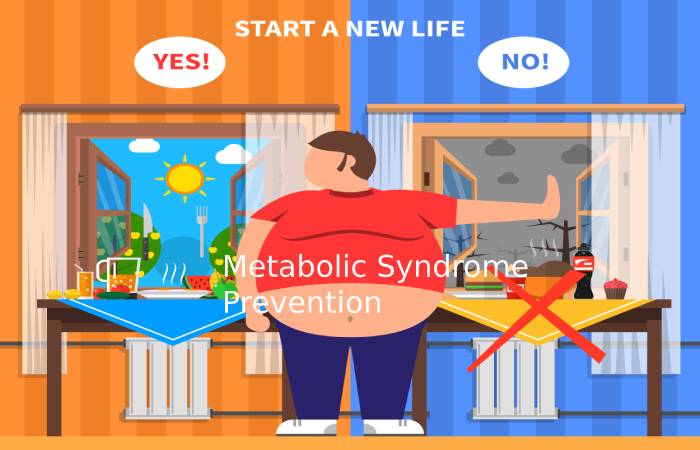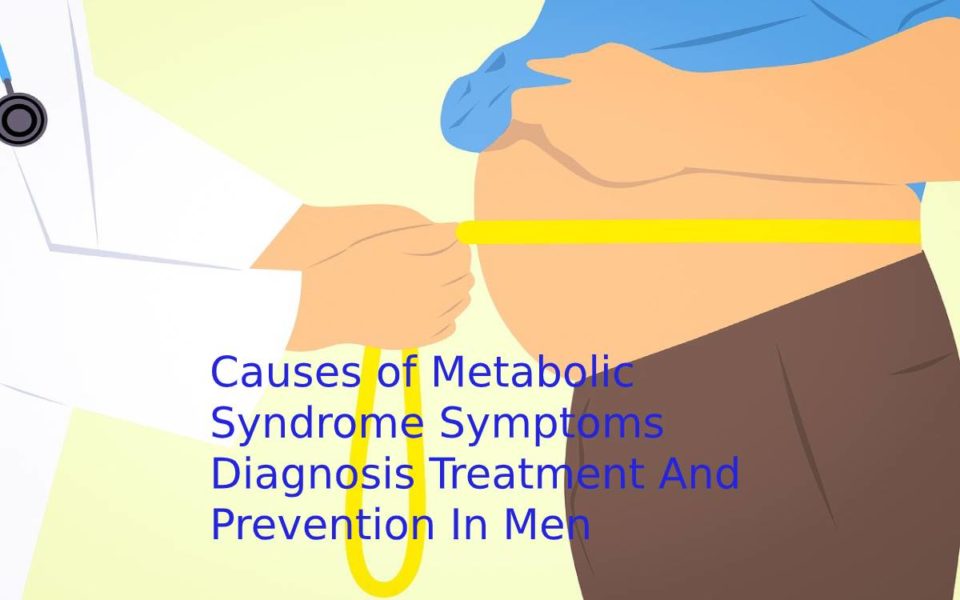Metabolic syndrome is one of the most pressing problems of modern medicine associated with maintaining an unhealthy lifestyle.
Table of Contents.
Metabolic syndrome is a complex of metabolic disorders in which the risk of developing cardiovascular disease and type 2 diabetes will increase. A decrease in physical activity and a high-calorie diet are the main reasons that the incidence of metabolic syndrome is increasing. Currently, it affects about 25% of the population.
How to determine its presence?
The prerequisites for the appearance of the metabolic syndrome are a sedentary lifestyle, overweight, and obesity, hypertension, the presence of coronary heart disease, type 2 diabetes, and some other diseases. It is essential to diagnose this disease in time and start treatment.
Causes of Metabolic Syndrome

Insulin is the body that performs many functions. But its main task is to contact the insulin-sensitive receptors that are in the membrane of each cell.
After that, the mechanism of transporting glucose from the intercellular space into the cell starts. Thus, insulin “opens the door” to the glucose cell.
If the receptors do not respond to insulin, then the hormone itself and glucose accumulate in the blood. The basis of the development of the metabolic syndrome is insulin insensitivity – insulin resistance. Several reasons can cause this phenomenon.
Genetic predisposition
some people have insulin insensitivity at the genetic level. The gene that is responsible for the development of the metabolic syndrome is on the 19th chromosome. His mutations can lead to the fact that
- cells lack receptors for insulin binding;
- receptors are not sensitive to insulin;
- the immune system produces antibodies that block insulin-sensitive receptors;
- the pancreas produces abnormal insulin. A diet high in fat and carbohydrates
Development of metabolic syndrome
The most critical factor in the event of metabolic syndrome, Saturated fatty acids, which come in large quantities with animal fats, contribute to the development of obesity.
Besides, fatty acids cause changes in the membranes of the cells, making them insensitive to the action of insulin. Excessively high-calorie nutrition leads to the fact that much glucose and fatty acids enter the bloodstream.
Their excess deposit in fat cells in subcutaneous fat, as well as in other tissues, and leads to decrease sensitivity to insulin.
A sedentary lifestyle
A decrease in physical activity entails a reduction in the rate of all metabolic processes, including the breakdown and absorption of fats. Fatty acids block the transport of glucose into the cell and reduce the sensitivity of its membrane to insulin.
Prolonged untreated arterial hypertension
Prolonged untreated arterial hypertension. It causes a violation of peripheral circulation, which is accompanied by a decrease in tissue sensitivity to insulin.
Addiction to low-calorie diets
Addiction to low-calorie diets. If the caloric content of the daily diet is less than 300 calories, this leads to irreversible metabolic disorders. The body “saves” and builds up reserves, which leads to increased fat deposition.
Organs and Tissues
Long-term mental stress and stress disrupt the nervous regulation of organs and tissues. Therefore due to that, the production of hormones, including insulin and the reaction of cells to them, is disrupted.
Taking insulin opponents :
- glucagon;
- oral contraceptives;
- thyroid hormones.
These drugs reduce the absorption of glucose by the tissues, which accompanied by a decrease in sensitivity to insulin.
Treatment of Diabetes
An overdose of insulin in the treatment of diabetes. Improper treatment leads to a large amount of insulin in the blood. It is addictive to receptors. In this case, insulin resistance is a kind of protective reaction of the body from a high concentration of insulin.
Hormonal disorders.
Adipose tissue is an endocrine organ and secretes hormones that decrease insulin sensitivity. Moreover, the more pronounced obesity, the lower the sensitivity.
In women, with increased production of testosterone and reduced estrogen, fats accumulate according to the “male” type, blood vessels function, and arterial hypertension develops.
A decrease in the level of thyroid hormones can also cause an increase in the level of lipids (fats) in the blood and the development of insulin resistance.
Age-related changes in men
Testosterone production decreases with age, consequently, which leads to insulin resistance, obesity, and hypertension.
Apnea in a dream.
Apnea in a dream. Holding the breath in an idea causes oxygen starvation of the brain and increased the production of growth hormone. This substance contributes to the development of insulin sensitivity.
Symptoms of the metabolic syndrome

Consider all the criteria shown below.
- In contrast, The first and mandatory test is abdominal obesity., i.e., obesity, in which adipose tissue is deposited mainly in the abdomen.
- Sometimes this obesity is called obesity “apple type” or “android.” Fatty tissue gathers not only below the skin but also around the internal organs. It not only squeezes them, complicating their work but also plays the role of the endocrine organ.
- Fat secretes substances that contribute to the appearance of inflammation, an increase in the level of fibrin in the blood, which increases the risk of blood clots. Fat deposition mainly in the thighs and buttocks (“pear-like,” “ganoids”) does not have such adverse effects.
- Arterial hypertension can diagnose if the systolic blood pressure is greater than or equal to 130 mm. Hg. Art., diastolic more or equal to 85 mm. Hg. Art. Red spots on the chest and neck. These are signs of increased pressure associated with vasomotor, which is caused by an excess of insulin.
- Violations of the lipid spectrum. Diagnostics will require a biochemical blood test: determination of the level of triglycerides and high-density lipid-protein cholesterol.
- Impaired carbohydrate metabolism will consider being a fasting blood glucose level of more than 5.6 mmol / l, or treatment with hypoglycemic agents.
Diagnosis of metabolic syndrome
If necessary, the attending physician will prescribe an additional examination:
daily monitoring of blood pressure, ECG, ultrasound of the heart and blood vessels, determination of biochemical parameters of blood lipids, liver and kidney function tests, determination of blood glucose 2 hours after eating, or after an oral glucose tolerance test.
Metabolic Syndrome Treatment

The treatment of the metabolic syndrome consists of maintaining a healthy lifestyle and drug therapy. Changing lifestyle means changing diet, exercise, and giving up bad habits. Pharma therapy (prescription of drugs) will not affect if the patient does not follow the rules of nutrition and the regime of physical activity.
Nutritional recommendations for metabolic syndrome
Stringent diets and starvation will not recommend. Weight loss should be gradual (5-10% in the first year). As a result, at the fast pace of weight loss, it is difficult for the patient to maintain the result, almost always lost kilograms also quickly return.
Changing the composition of food will be more useful and practical. Hence, reducing the consumption of animal fats, replacing animal fats with vegetable fats, increasing the use of plant fiber, fiber, and reducing the consumption of salt.
-
- You should almost completely exclude sweet carbonated drinks, confectionery, fast food.
- It is better to limit the use of bread to 150-200 grams per day.
- Soups should be mainly vegetables.
- From meat products, it is better to choose low-fat varieties of beef, poultry, or fish in boiled or aspic form.
- It is better to use buckwheat and oats, millet, and grains
- It is better to limit the cornmeal as much as possible.
- Potatoes, carrots, beets, it is recommended to eat no more than 200 grams per day. Similarly, fiber-rich vegetables (tomatoes, cucumbers, bell peppers, cabbage, lettuce, radishes, zucchini) and greens can be consumed almost without restrictions in raw and boiled or baked form.
- The recommendation of eggs not more than 1-2 pieces per day.
- Consumption of fruits and berries up to 200-300 grams per day additionally, reduces metabolic syndrome.
- Milk of minimum fat content, low-fat sour-milk products, and cheese – 1-2 cups per day, and also, Cream, fatty cheeses, we recommend using sour Cream occasionally.
List of Recommended Products:

- WE have to limit low-fat varieties of animal meat (veal, rabbit, chicken without skin) and poultry 150-200 grams per day.
- Limit of fish and seafood not more than 150 grams.
- Eggs one or two per day in the form of an omelet or hard-boiled.
- Low-fat dairy products are recommended.
- Limit the cottage cheese 100-200 grams per day
- Low-fat and non-sharp varieties of hard cheese should limited to 30 grams.
- Low-fat beef sausages or boiled sausage only two times a week.
- Indeed, 25% of vegetables in raw form, the rest in stewed, boiled, baked, steamed are recommended to consume (at least 400 grams).
Recommended green vegetables:
- Unsweetened fruits and berries up to 400 g. Fresh, frozen, or canned without sugar.
- Collard greens washed with water;
- Porridge from pearl barley, buckwheat, egg groats, brown rice. 150-200 g per serving, subject to bread restriction;
- First courses (250-300 g) on a low fat, meat, fish or mushroom broth, vegetarian soups;
- Whole meal bread, bran products up to 200 g;
- Teas, fruit and vegetable juices without sugar;
- A strip of dark chocolate, jelly and sugar substitute mousse;
- Fluid intake is limited to 1.5 liters hence, it causes an increased breakdown of fats in the body.
It is necessary to refuse such products:
- Confectionery: sweets, cookies, products with Cream is not good for health.
- Consequently, baking, especially rich and flaky decreases the immune system.
- Fatty meats: pork, lamb, duck high in take will increase in uric acid.
- Canned food, smoked turkey, and fish, sausage, ham these are in high cholesterol.
- Rice, semolina, and oatmeal, pasta are high in carbohydrates which increase in fat.
- Cream, sweet yogurt, fatty cottage cheese, and products from it are rich in sugars.
- Margarine, cooking oil these lead to triglycerides.
- Raisins, bananas, grapes, dates and other fresh fruits gives heat to body.
- Mayonnaise, fatty, spicy sauces, spices not good for health.
- Sugary drinks, juices, and with sugar which increase in fat and cholesterol.
once every 1-2 weeks, you can take a day off and use “unwanted” foods moderately.
Recommendations for exercise regimen in metabolic syndrome
A gradual increase in physical activity is recommended. Nevertheless, such sports as walking, running, gymnastics, swimming should be preferred. In the same way, the main thing is that physical activity is regular and consistent with your capabilities.
Medication for metabolic syndrome
However, Drug therapies of the metabolic syndrome at treating obesity, disorders of carbohydrate metabolism, arterial hypertension, and dyslipidemia. Therefore, endocrinologists treat metabolic syndrome, given that a variety of pathological changes occur in the patient’s body.
Hence, a consultation may be required: therapist, cardiologist, nutritionist.
Metabolic Syndrome Prevention

- Eat right: Eat-in regular intervals simultaneously, five to six times in small quantities. So , that you should not have a feeling of hunger. Otherwise, the body, receiving nutrients, stores them in reserve contributes to the development of obesity.
- Move more: So, It helps burn calories and normalizes metabolism. Similarly, use every opportunity to be physically active, go to work on foot, go up the stairs, wash the floor with your hands, and not with a mop.
- Buy a subscription to the gym or pool: Thus, the money spent will encourage you to attend classes.
- Massage and self-massage: It normalizes blood circulation in tissues, especially in the lower extremities, as a result, makes cells more sensitive to the effects of insulin.
- Take a course in Physical therapy: controlling excitement, accordingly, mud therapy ideally speed up the metabolism—referral to your physician’s office from your healthcare provider.
- Radiotherapy: Leech treatment improves all blood characteristics and normalizes blood flow, therefore which is essential to maintain metabolism in the body.
- Watch your cholesterol: After 40 years, probably, at least once a year, check the level of “good” and “bad” cholesterol so that treatment can be started in time if necessary.


